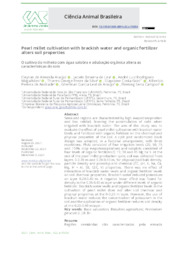Pearl millet cultivation with brackish water and organic fertilizeralters soil properties.
Pearl millet cultivation with brackish water and organic fertilizeralters soil properties.
Author(s): ARAÚJO, C. de A.; LIRA, J. B. de; MAGALHÃES, A. L. R.; SILVA, T. G. F. da; GOIS, G. C.; ANDRADE, A. P. de; ARAUJO, G. G. L. de; CAMPOS, F. S.
Summary: Semi-arid regions are characterized by high evapotranspiration and low rainfall, favoring the accumulation of salts when irrigated with brackish water. The aim of this study was to evaluate the effect of pearl millet cultivation with brackish water levels and fertilized with organic fertilizer on the chemical and physical properties of the soil. A split plot randomized block design was adopted, in a factorial arrangement, with three repetitions. Plots consisted of four irrigation levels (25, 50, 75 and 100% crop evapotranspiration) and subplots consisted of four levels of organic fertilizer (0; 15; 30 and 45 Mg ha-1). At the end of the pearl millet production cycle, soil was collected from layers 0-0.20 m and 0.20-0.40 m, for physical (soil bulk density, particle density and porosity) and chemical (EC, pH, K, Na, Ca, Mg, H + Al, SB, CEC, V) properties. There was no effect of interaction of brackish water levels and organic fertilizer levels on soil chemical properties. Brackish water reduced potassium on layer 0.20-0.40 m. A negative linear effect was found for density in the 0.20-0.40 m layer under different levels of organic fertilizer. Brackish water levels and organic fertilizer levels in the cultivation of pearl millet does not alter soil chemical and physical properties at the 0-0.20 m layer. However, the use of brackish water reduces the concentration of potassium in the soil and the application of organic fertilizer reduces soil density at the 0.20-0.40 m layer.
Publication year: 2021
Types of publication: Journal article
Unit: Embrapa Semi-arid Region
Observation
Some of Embrapa's publications are published as ePub files. To read them, use or download one of the following free software options to your computer or mobile device. Android: Google Play Books; IOS: iBooks; Windows and Linux: Calibre.
Access other publications
Access the Agricultural Research Database (BDPA) to consult Embrapa's full library collection and records.
Visit Embrapa Bookstore to purchase books and other publications sold by Embrapa.

